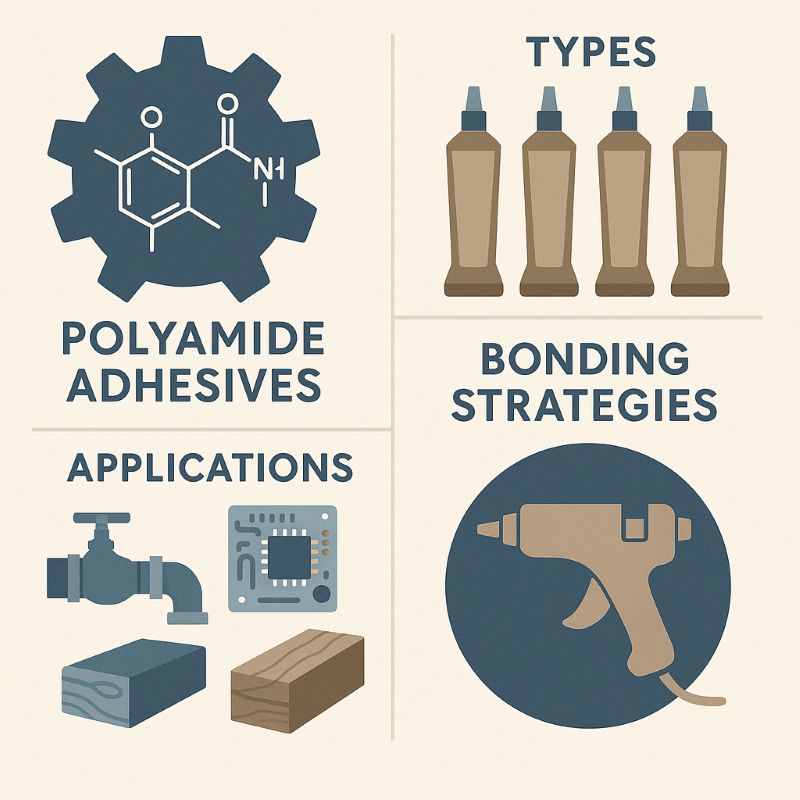
Understanding Polyamide Adhesives
Types of Polyamide Adhesives
Importance of Polyamide Bonding
Optimal Bonding Methods
Latest Trends in Adhesive Technology
Strategies for Effective Bonding
Polyamide Adhesives in Industry
Frequently Asked Questions (FAQ)
Polyamide adhesives are high-performance thermoplastic materials widely recognized for their strong bonding ability and excellent resistance to heat and chemicals. They are particularly suitable for use in environments that demand durability, such as industrial assembly, electronics, filtration systems, and automotive components. These adhesives offer fast-setting times and superior adhesion to various substrates, making them an efficient solution for both general and specialized applications.
Polyamide adhesives are typically categorized into three major types:
Thermoplastic Polyamides: These are reworkable and offer flexibility, often used in applications that require future disassembly or repairs.
Thermosetting Polyamides: Once cured, they form highly durable, rigid bonds with excellent chemical and heat resistance.
Reactive Polyamide Systems: These adhesives chemically react during curing, resulting in highly robust, permanent bonds.
Each type has unique properties suited to different operational needs. Choosing the right category ensures the adhesive performs optimally in its intended environment.
Polyamide adhesives are engineered to create strong and durable bonds in demanding environments. They are often preferred for their ability to maintain adhesion under elevated temperatures and in the presence of oils, fuels, or chemicals. Effective bonding enhances both product performance and service life, reducing failure rates and minimizing maintenance requirements. This makes polyamide adhesives especially valuable in applications where reliability and operational safety are critical.
For optimal results when using polyamide adhesives:
Surface Preparation: Ensure all bonding surfaces are clean, dry, and free from dust, oil, or oxidation.
Correct Temperature Range: Apply within the recommended melt temperature to ensure proper flow and wetting of surfaces.
Controlled Pressure: Maintain sufficient pressure during cooling to achieve intimate surface contact and strong bonds.
Equipment Compatibility: Use appropriate dispensing equipment to ensure uniform application and flow control.
Following these methods enhances bond integrity and consistency in industrial production.
The adhesive industry is shifting toward more sustainable and high-efficiency solutions. Current trends include:
Eco-Friendly Formulations: Development of adhesives made with bio-based materials or lower VOC emissions.
Fast-Curing Systems: Designed to reduce assembly time and energy consumption.
Smart Adhesives: Emerging solutions include adhesives embedded with sensing capabilities for quality control.
Low Pressure Molding Compatibility: Some polyamide adhesives are now tailored for electronics encapsulation and protective sealing without damaging sensitive components.
These trends reflect the industry’s evolution toward smarter, cleaner, and more versatile bonding technologies.
To maximize adhesive performance:
Match Adhesive to Application: Consider whether thermal resistance, reworkability, chemical resistance, or flexibility is most critical.
Environmental Controls: Bonding in stable temperature and humidity conditions improves outcome predictability.
Process Optimization: Integrate quality checks during bonding to ensure surface integrity and correct alignment.
Preventative Maintenance: Regularly service adhesive application equipment to avoid contamination or inconsistent flow.
Implementing these strategies reduces error rates and ensures long-term bond strength.
Polyamide adhesives are widely used across:
Automotive Manufacturing: For filters, sensors, and under-the-hood bonding tasks.
Electronics Assembly: In low-pressure molding and encapsulation applications.
Filtration Industry: Bonding materials exposed to fuels, high temperature, or pressure fluctuations.
Textile & Footwear: For flexible, fast-setting adhesives in high-volume production lines.
Their thermal stability, mechanical strength, and rapid curing properties make them indispensable in sectors that demand both performance and efficiency.
Q1. What are polyamide adhesives used for?
They are used for bonding in high-performance environments such as automotive, electronics, filters, and textiles due to their thermal resistance and durability.
Q2. What are the main types of polyamide adhesives?
Thermoplastic (reworkable and flexible), thermosetting (rigid and chemically resistant), and reactive systems (permanent, chemical bonding).
Q3. Why is polyamide bonding important?
It ensures long-lasting adhesion in harsh environments, enhancing product reliability and operational performance.
Q4. How can I achieve optimal bonding with polyamide adhesives?
Use clean surfaces, proper application temperatures, and the right dispensing tools. Apply adequate pressure and follow curing recommendations.
Q5. What trends are emerging in adhesive technology?
Sustainable adhesives, faster curing systems, sensor-enabled adhesives, and materials suited for protective molding in electronics are key innovations.
Q6. What factors affect the bonding process?
Surface condition, adhesive type, environmental temperature/humidity, and application method all influence bonding quality.
Q7. How does thermal resistance affect adhesive selection?
In high-heat or fluctuating temperature environments, high thermal resistance is essential for maintaining bond integrity.
Q8. Are polyamide adhesives suitable for automated production?
Yes, their fast setting and compatibility with standard dispensing equipment make them ideal for high-throughput industrial lines.